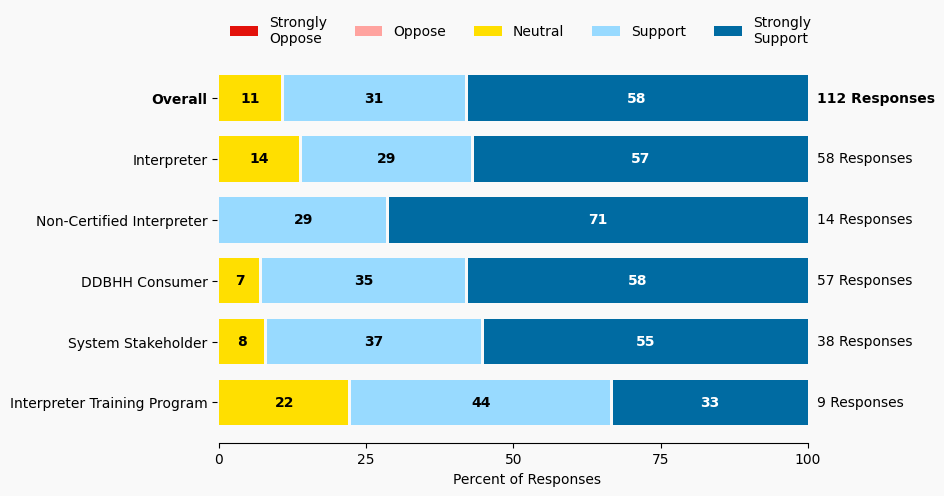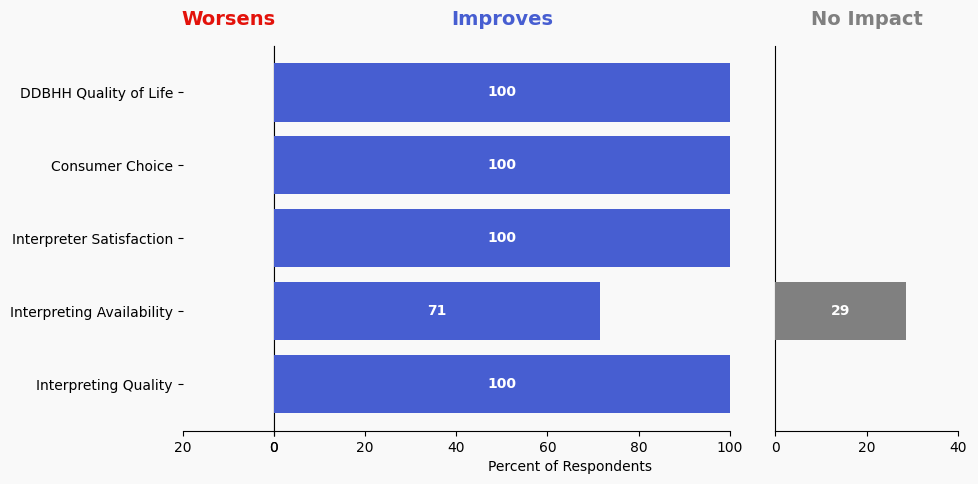102 Emphasize Direct Community Experience as Part of ITPs
Issue: Many new interpreters appear to have a disconnect from the DDBHH community experience, according to some DDBHH people and seasoned interpreters’ perspectives. Consumers report interpreters’ skills are not as strong, and the understanding and empathy, which are important aspects for successful communication and interpretation, are missing due to the lack of connection with DDBHH people’s experiences.
Proposed Solution: ITPs develop more programming and requirements for interpreting students to engage directly with the DDBHH community. Suggestions shared include: Service learning Shadowing DDBHH people to observe their management of interpreting services Community service activities with DDBHH organizations
Expected outcome: Interpreting students will become better interpreters by having greater exposure, gaining more experiences and enhancing their ASL skills and understanding of Deaf culture through these interactions. In the process, familiarity amongst students and DDBHH community members will aid in developing professional relationships later.
Who is impacted: Consumers, interpreters
Timeline: 6 months

Summary of Support Image Description
The stacked bar charts show how respondents rated their level of support and the total number of responses. The percentage for the five support levels is shown from left to right: Strongly Oppose (Dark Red), Oppose (Light Red), Neutral (Yellow), Support (Light Blue), and Strongly Support (Dark Blue).
Respondents may identify with multiple subgroups. The overall level of support is:
Overall
Strongly Oppose: 0%
Oppose: 0%
Neutral: 11%
Support: 31%
Strongly Support: 57%
Click to see the detailed image description for each subgroup.
Interpreter
Strongly Oppose: 0%
Oppose: 0%
Neutral: 14%
Support: 28%
Strongly Support: 56%
Non-Certified Interpreter
Strongly Oppose: 0%
Oppose: 0%
Neutral: 0%
Support: 28%
Strongly Support: 71%
DDBHH Consumer
Strongly Oppose: 0%
Oppose: 0%
Neutral: 7%
Support: 35%
Strongly Support: 57%
Interpreter Training Program
Strongly Oppose: 0%
Oppose: 0%
Neutral: 22%
Support: 44%
Strongly Support: 33%
System Stakeholder
Strongly Oppose: 0%
Oppose: 0%
Neutral: 8%
Support: 37%
Strongly Support: 55%
Overview of Respondents Opting for In-Depth Solution Analysis
After indicating their support level, 5% of the 112 respondents opted in to further assess whether the solution would worsen or improve on five metrics. Of the opt-in reviewers (6 respondents), 100% supported the solution, 0% were neutral on the solution, and 0% opposed the solution.
The remaining 106 respondents did not opt in to further assess the solution. Of these people, 88% support the solution, 11% were neutral on the solution, and 0% opposed the solution.
Reviewer Evaluation of Solution Effectiveness

Solution Effectiveness Image Description
The stacked bar charts show how respondents assessed the effectiveness of this solution based on five metrics. For each metric, the percentage of respondents is shown from left to right: Worsens (Red), Improves (Blue), No Impact (Gray).
DDBHH Quality of Life
Makes It Worse 0%
Makes It Better 100%
No Impact 0%
Interpreter Satisfaction
Makes It Worse 0%
Makes It Better 100%
No Impact 0%
Consumer Choice
Makes It Worse 0%
Makes It Better 100%
No Impact 0%
Interpreting Availability
Makes It Worse 0%
Makes It Better 71%
No Impact 28%
Interpreting Quality
Makes It Worse 0%
Makes It Better 100%
No Impact 0%
Reviewer Feedback and Insights
Interpreter
Comments from Interpreters note that ficial burdens may make it difficult for recent graduates to volunteer their time, proposing more paid internships and temp jobs through referral agencies or DDBHH organizations. One comment asks about the barriers to requiring community interaction in ITPs, suggesting that students could benefit from an updated list of community events to facilitate participation. Another comment shares that some ITPs do not currently require community interaction and agrees that attending a few events per semester would greatly benefit students, especially for students new to Deaf culture.
Deaf, DeafBlind, Hard of Hearing
Comments from DDBHH strongly endorses the solution, emphasizing that real-world experience will improve ASL skills, deepen understanding of Deaf culture, and foster empathy among interpreters.
System Stakeholder
Comments from System stakeholders support the proposed solution and highlight the importance of this approach in fostering a sense of giving back to the community among new interpreters. One comment suggests developing a system to monitor student community interactions and track their progress.
PREVIOUS SOLUTION
101 Review Historical ITP Results
Issue: Comprehensive and accessible data about ITP results is not readily available.
NEXT SOLUTION
103 Encourage Community Input on Interpreter Training Program Curricula
Issue: Consumers and ITPs do not generally have regular communication about ITP curriculum.
Leave a Reply